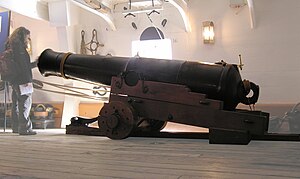68 pounder 95 cwt
| 68-pounder smoothbore cannon | |
|---|---|

Replica 68-pounder aboard HMS Warrior.
|
|
| Type |
Naval gun Coast Defence gun |
| Place of origin | United Kingdom |
| Service history | |
| In service | 1846–1921 |
| Used by | United Kingdom |
| Wars | Crimean War |
| Production history | |
| Designer | William Dundas |
| Manufacturer | Low Moor Iron Works |
| Unit cost | £225 |
| Produced | 1841–1861 |
| No. built | In excess of 2,000 |
| Specifications | |
| Weight | 88, 95 or 112 cwt |
| Barrel length | 88 cwt: 9 feet 6 inches (2,896 mm) 95 cwt: 10 feet (3,048 mm) 112 cwt: 10 feet 10 inches (3.302 m) |
| Crew | 9 – 18 |
|
|
|
| Shell |
Solid Shot Explosive Shell |
| Shell weight | 68 pounds (30.84 kg) |
| Calibre | 8.12 inches (20.62 cm) |
| Elevation | 0 – 15 degrees |
| Muzzle velocity | 1,579 feet per second (481 m/s) |
| Effective firing range | Approximately 3,000 yards (2,700 m) |
| Maximum firing range | 3,620 yards (3,310 m) |
The 68-pounder cannon was an artillery piece designed and used by the British Armed Forces in the mid-19th century. The cannon was a smoothbore muzzle-loading gun manufactured in several weights, the most common being 95 long cwt (4,800 kg), and fired projectiles of 68 lb (31 kg). Colonel William Dundas designed the 112 cwt version in 1841 and it was cast the following year. The most common variant, weighing 95 cwt, dates from 1846. It entered service with the Royal Artillery and the Royal Navy and saw active service with both arms during the Crimean War. Over 2,000 were made and it gained a reputation as the finest smoothbore cannon ever made.
The gun was produced at a time when new rifled and breech loading guns were beginning to make their mark on artillery. At first the 68-pounder's reliability and power meant that it was retained even on new warships such as HMS Warrior, but eventually new rifled muzzle loaders made all smoothbore muzzle-loading guns obsolete. However, the large surplus stocks of 68-pounders were given new life when converted to take rifled projectiles; the cannon remained in service and was not declared obsolete until 1921.
The cannon was designed in response to the need for heavier weaponry as armour on ships of the line improved. Colonel William Dundas, the government's Inspector of Artillery between 1839 and 1852, designed the cannon in 1846. It was cast by the Low Moor Iron Works in Bradford in 1847 and entered service soon after. Like numerous cannon before it, it was a cast iron smoothbore loaded from the muzzle. The cannon was relatively cheap to produce – the Royal Commission on the Defence of the United Kingdom estimated that each cannon cost approximately £167.(2010 : £12645). Over 2000 were cast before 1861 and its exceptional durability, range and accuracy earned it a reputation as the finest smoothbore cannon ever made.
...
Wikipedia
